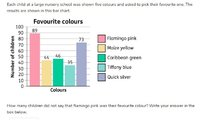Please tell us where that 500 came from, to bring closure to the question. How did you resolve the problem?
Well, as in every problem I had to solve in this test, there is a (functional) logic side that has to be applied, as well.
Similar to (for example): "A teacher is taking kids of a class to a one day trip, there are 18 students in the class, one minibus can accomodate 12 students, how many minibuses are needed?" the mathematic answer is 1.5 minibuses but the logic answer is 2 (because half minibus is not functional anyway).
Now, in my example,, what made me think is: a "large" nursery and how many children "did not say pink" is their favourite colour We can add up the 4 columns and get the result. But, there might be children who said others colours as well, others than the 5th colours and there could be as well children who maybe did not say anything - no reply - picked no option from the 5 colours presented (the kids were shown 5 colours but there are 11 basic colours out there), or may not having been to the nursery in that day, or any other million possibilities. Since the highest round number close to the highest number counted in our situation (89) is 100, the graph has been raised up to 100, in order to be able to accomodate the total number of children in terms of adding up. If the question of the problem would been "how many children picked the others 4 colours as their favourite instead of pink?" then that would been a plain, specific question, needed a clear solving by adding up the values in the 4 columns colours, except pink. But, how many kids "did not say pink" leaves the door open to a whole loads lot plenty of interpretation, logic and speculation, which is why I posted this problem here.
Right or wrong? (puppy eyes)

